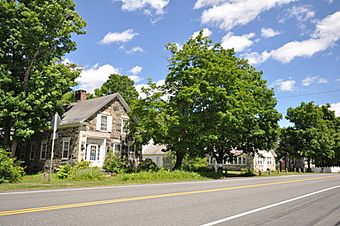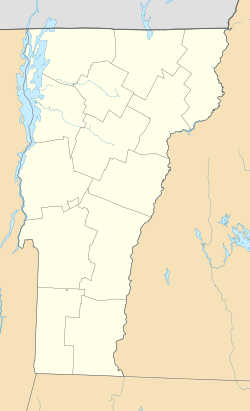Stone Village Historic District facts for kids
Quick facts for kids |
|
|
Stone Village Historic District
|
|
 |
|
| Location | Both sides of VT 103 N of Williams River, Chester, Vermont |
|---|---|
| Area | 100 acres (40 ha) |
| Built | 1834 |
| Built by | Clark, Alison & Wiley |
| Architectural style | Greek Revival, Cape Cod; I house |
| NRHP reference No. | 74000329 |
| Added to NRHP | May 17, 1974 |
The Stone Village Historic District is a special place in Chester, Vermont. It's known for its unique stone buildings. These buildings were made a long time ago, in the early 1800s. What makes them special is how they were built, using a technique brought by skilled masons from Scotland. This district was added to the National Register of Historic Places in 1974 because of its historical importance.
The Story of the Stone Village
In the early 1830s, talented stone builders, called masons, came to Vermont from Scotland. Many of them were from a place called Aberdeen. They knew a special way to build with stone called "snecked ashlar." This method uses flat pieces of stone attached to a wall made of rougher stones.
This building style is quite rare in the United States. You can find about 50 buildings made this way in the state of Vermont. The biggest group of these buildings is in Chester, along Vermont Route 103. This area is known as the Stone Village.
How the Stone Buildings Were Built
Two Scottish masons, brothers Alison and Wiley Clark, arrived in Chester in 1832. They first worked on a large factory building that is no longer there. In 1834, a doctor named Ptolmey Edson hired the brothers. He wanted them to build his house, which became the first "snecked ashlar" building in the village.
After the doctor's house, many other buildings were constructed this way. Most of these were homes. The local church and school were also built of stone. This might have been because Dr. Edson was involved in planning those buildings.
Most of the stone houses are either one-and-a-half stories tall, like a "Cape-style" house, or two stories tall. They often have decorative details from the "Greek Revival" style. Out of the seventeen buildings in the district, thirteen are made of stone. The other four were built around the same time, between 1830 and 1850. Sadly, a large wooden building, which was a tavern, was destroyed by fire in 2012.



